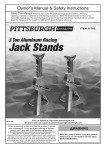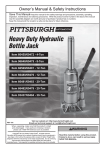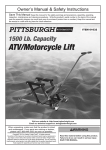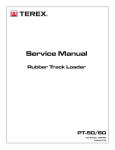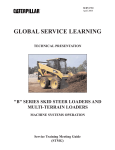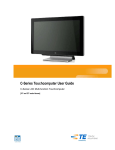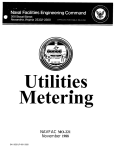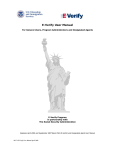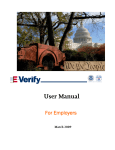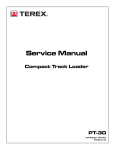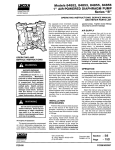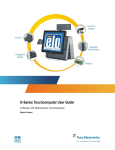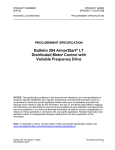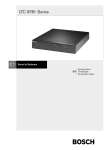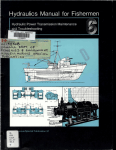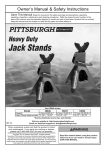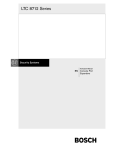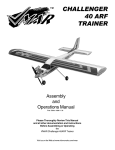Download Disassembly and - Cutting Edge Machinery
Transcript
Service Manual RC-60 & RC-60 Turf Edition Rubber Track Loaders Safety Overview Technical Specifications System Diagrams Disassembly and Assembly Instructions Troubleshooting Maintenance Hydraulic Pressure Check & Adjustment ASVSP005 (07/04) Part Number: 2030-184 Table of Contents Light Bar Installation ......................................... 5-2 Ignition Switch Removal and Installation ................ 5-2 Ignition Switch Removal.................................... 5-2 Ignition Switch Installation................................. 5-3 Console Gauge/Warning Panel Removal and Installation .............................................................. 5-4 Console Gauge Removal.................................. 5-4 Console Gauge Installation............................... 5-4 Lap Bar Gas Assist Spring Removal and Installation ....................................................... 5-5 Lap Bar Gas Assist Spring Removal................. 5-5 Lap Bar Gas Assist Spring Installation.............. 5-5 1. Product Safety Chapter Overview................................................... 1-1 Safety Messages .................................................... 1-1 Information Messages ............................................ 1-1 Basic Precautions................................................... 1-1 Safety Signs ...................................................... 1-1 Protective Equipment ........................................ 1-2 Mounting and Dismounting ............................... 1-2 Lifting ................................................................ 1-2 Hot Fluids and Parts.......................................... 1-2 Corrosion Inhibitor............................................. 1-2 Batteries............................................................ 1-2 Pressurized Items ............................................. 1-2 Repair..................................................................... 1-3 Work Tools ............................................................. 1-3 Asbestos Information.............................................. 1-4 Machine Labels and Decals ................................... 1-4 Product ID Number ........................................... 1-4 Machine Label and Decal Examples ................. 1-5 6. Chassis Disassembly and Assembly Chapter Overview................................................... 6-1 Personal Safety ...................................................... 6-1 Machine Preparation .............................................. 6-1 Preliminary Checkout ............................................. 6-1 Chassis Disassembly and Assembly Procedures............................................................. 6-1 Seat Removal and Installation................................ 6-1 Seat Removal ................................................... 6-1 Seat Installation ................................................ 6-2 Fuel Sending Unit Removal and Installation........... 6-2 Fuel Sending Unit Removal .............................. 6-3 Fuel Sending Unit Installation ........................... 6-3 2. Technical Specifications Chapter Overview................................................... 2-1 Specifications ......................................................... 2-1 Engine............................................................... 2-1 Transmission..................................................... 2-1 Drive Motors...................................................... 2-1 Control Handles ................................................ 2-1 Auxiliary Pump .................................................. 2-1 Loader Valve..................................................... 2-1 Cooler ............................................................... 2-1 7. Radiator/Oil Cooler Disassembly and Assembly Chapter Overview................................................... 7-1 Personal Safety ...................................................... 7-1 Machine Preparation .............................................. 7-1 Preliminary Checkout ............................................. 7-1 Radiator/Oil Cooler Disassembly and Assembly Procedures............................................................. 7-1 Fan Guard Removal and Installation ...................... 7-1 Fan Guard Removal.......................................... 7-2 Fan Guard Installation....................................... 7-2 Radiator/Cooler Removal and Installation .............. 7-2 Radiator/Cooler Removal.................................. 7-2 Radiator/Cooler Installation............................... 7-4 3. System Diagrams Chapter Overview................................................... 3-1 Filtering and Cooling System.................................. 3-1 Auxiliary Circuit System (RC-60) ............................ 3-2 Drive Loop System (RC-60) ................................... 3-3 Auxiliary Circuit System (R-60)……………………...3-4 Drive Loop System (R-60)……………………………3-5 4. Machine Controls and Instrumentation Chapter Overview................................................... 4-1 Machine Controls.................................................... 4-1 Loader Control .................................................. 4-1 Drive Control ..................................................... 4-1 Throttle.............................................................. 4-1 Dash Panel............................................................. 4-1 Gauge/Warning Light Panel ................................... 4-2 8. Hydraulic Reservoir Disassembly and Assembly Chapter Overview................................................... 8-1 Personal Safety ...................................................... 8-1 Machine Preparation .............................................. 8-1 Preliminary Checkout ............................................. 8-1 Hydraulic Reservoir Disassembly and Assembly Procedures............................................................. 8-1 Filter Assembly Removal and Installation............... 8-1 Filter Manifold Removal .................................... 8-2 Filter Manifold Installation ................................. 8-2 Access Cover Removal and Installation ................. 8-2 Access Cover Assembly Removal .................... 8-2 Access Cover Assembly Installation ................. 8-3 Reservoir Gauge Removal and Installation ............ 8-3 Reservoir Gauge Removal................................ 8-3 Reservoir Gauge Installation............................. 8-4 5. Operator Enclosure Disassembly and Assembly Chapter Overview................................................... 5-1 Personal Safety ...................................................... 5-1 Machine Preparation .............................................. 5-1 Preliminary Checkout ............................................. 5-1 Operator Enclosure Disassembly and Assembly Procedures ............................................................. 5-1 Light Bar Removal and Installation ......................... 5-1 Light Bar Removal............................................. 5-1 i Rubber Track Loader Table of Contents Suction Screen Removal and Installation ............... 8-4 Suction Screen Removal................................... 8-5 Suction Screen Installation................................ 8-5 Hydraulic Reservoir Cleaning Procedures............. 8-6 Hydraulic Reservoir Cleaning............................ 8-6 Machine Preparation ............................................ 12-1 Preliminary Checkout ........................................... 12-1 Loader Disassembly and Assembly Procedures . 12-1 Lift Cylinder/Tilt Cylinder Removal and Installation ..................................................... 12-1 Lift Cylinder/Tilt Cylinder Removal .................. 12-1 Lift Cylinder/Tilt Cylinder Installation ............... 12-3 Low-Flow Relief Valve Removal and Installation.. 12-3 Low-Flow Relief Valve Removal ..................... 12-3 Low-Flow Relief Valve Installation .................. 12-6 9. Loader/Transmission Controls Disassembly and Assembly Chapter Overview................................................... 9-1 Personal Safety ...................................................... 9-1 Machine Preparation .............................................. 9-1 Preliminary Checkout ............................................. 9-1 Loader/Transmission Controls Disassembly and Assembly Procedures............................................. 9-1 Joystick Removal and Installation........................... 9-1 Joystick Removal .............................................. 9-1 Joystick Installation ........................................... 9-3 Loader Float Magnet Removal and Installation ...... 9-4 Loader Float Magnet Removal.......................... 9-4 Loader Float Magnet Installation ....................... 9-6 Loader Valve Removal and Installation ................. 9-7 Loader Valve Removal...................................... 9-7 Loader Valve Installation................................... 9-9 13. Maintenance Chapter Overview................................................. 13-1 Maintenance Schedule......................................... 13-1 Engine Oil............................................................. 13-1 Oil Change Procedures................................... 13-1 Engine Oil Specifications ................................ 13-1 Hydraulic Fluid and Filter...................................... 13-2 Hydraulic Fluid and Filter Change Procedures...................................................... 13-2 Fuel Filter ............................................................. 13-3 Fuel Filter Change Procedures ....................... 13-3 Fuel Specifications.......................................... 13-3 Air Cleaner ........................................................... 13-3 Air Filter Change Procedures.......................... 13-3 Track Tension....................................................... 13-4 Track Tension Adjustment Procedures ........... 13-4 Checking for Proper Track Adjustment ........... 13-4 Fuse Box .............................................................. 13-4 Grease Fittings ..................................................... 13-5 10. Transmission and Drive Disassembly and Assembly Chapter Overview................................................. 10-1 Personal Safety .................................................... 10-1 Machine Preparation ............................................ 10-1 Preliminary Checkout ........................................... 10-1 Transmission and Drive Disassembly and Assembly Procedures.................................... 10-1 Auxiliary Gear Pump Removal and Installation .... 10-1 Auxiliary Gear Pump Removal ........................ 10-1 Tandem Pump Removal and Installation.............. 10-3 Tandem Pump Removal ................................. 10-3 Tandem Pump Installation .............................. 10-4 Pump Drive Coupler Removal and Installation ..... 10-5 Pump Drive Coupler Removal......................... 10-5 Pump Drive Coupler Installation...................... 10-6 14. Hydraulic Pressure Check & Adjustment Charge Pressure check……………………………. 14-1 Charge Pressure Adjustment………………………14-2 Drive Pressure Adjustment…………………………14-3 Auxiliary Pressure Check & Adjustment…………..14-4 15. Troubleshooting Chapter Overview................................................. 15-1 Personal Safety .................................................... 15-1 Machine Preparation ............................................ 15-1 Preliminary Checkout ........................................... 15-1 Visual Inspection............................................. 15-1 Operational Checks ........................................ 15-1 Troubleshooting Scenarios………………………...15-2 11. Undercarriage Disassembly and Assembly Chapter Overview................................................. 11-1 Personal Safety .................................................... 11-1 Machine Preparation ............................................ 11-1 Preliminary Checkout ........................................... 11-1 Undercarriage Disassembly and Assembly Procedures ........................................................... 11-1 Wheel Removal .................................................... 11-1 Wheel Removal............................................... 11-2 Sprocket Roller Removal and Installation............ 11-3 Track Removal and Installation ........................... 11-3 Track Removal ................................................ 11-4 Track Installation ............................................. 11-5 Sprocket Bearing Removal................................... 11-6 Sprocket Bearing Plate Removal .................... 11-6 Sprocket Removal and Installation ....................... 11-7 Sprocket Removal........................................... 11-7 Drive Motor Removal and Installation.................. 11-8 12. Loader Disassembly and Assembly Chapter Overview................................................. 12-1 Personal Safety .................................................... 12-1 ii 1. Product Safety Note: This label is used to provide important additional information, comments, explanations or amplification of the accompanying subject matter. Chapter Overview This chapter contains product safety information for the RC-60 Rubber Track Loader. Read this chapter and understand all safety messages and information messages before attempting to service the machine. The person servicing the Rubber Track Loader may be unfamiliar with many of the systems on the machine. This makes it important to use caution when performing service work. Knowledge of the system and/or components is important before the removal or disassembly of any component. Safety Messages Safety messages are provided in this document and on the machine. If these hazard warnings are not heeded, bodily injury or death could occur to you or other persons. It is not possible to anticipate every circumstance that might involve a potential hazard. The safety messages in this document and on the product are, therefore, not all-inclusive. If you use a tool, procedure, work method or operating technique that is not specifically recommended by the manufacturer, you must satisfy yourself that it is safe for you and for others. You should also ensure that the product will not be damaged or be made unsafe by the operation, lubrication, maintenance or repair procedures that you choose. Hazards are identified by the Safety Alert Symbols !DANGER! … . !WARNING!….!CAUTION!. The meaning of these safety alerts is as follows: Attention! Become Alert! Your Safety is Involved. The message that appears under a Safety Alert Symbol explains the hazard and can be either written or pictorially presented. ! DANGER ! This symbol is used to alert service personnel of an imminently hazardous situation that will result in serious injury or death. Basic Precautions ! WARNING ! Improper operation, lubrication, maintenance or repair of this product can be dangerous and could result in injury or death. ! WARNING ! This symbol is used to alert service personnel of a potentially hazardous situation that could result in serious injury or death. Do not operate or perform any lubrication, maintenance or repair on this product until you have read and understood the operation, lubrication, maintenance and repair information. ! CAUTION ! Following is a list of basic precautions that should always be observed. This symbol is used to alert service personnel of an unsafe practice that could result in injury. Safety Signs Information Messages Read and understand all "Safety" signs on the product before operating, lubricating or repairing this product. Replace any damaged, illegible or missing safety plates, signs or decals. Information messages are provided in this document and on the machine. These messages are identified by the labels NOTICE….Note. NOTICE This label is used to alert service personnel to the possibility of damaging the equipment. 1-1 Rubber Track Loader 1. Product Safety Protective Equipment Batteries Always wear a hard hat, protective glasses, protective shoes and other protective equipment as required by job conditions when working around this product. In particular, wear protective glasses when pounding on any part of the product or its work tool with a hammer or sledge. Use welders gloves, hood/goggles, apron and other protective clothing appropriate to the welding job being performed. Do not wear loose clothing or jewelry that can catch on parts of the product. Do not smoke when inspecting the battery electrolyte level. Never disconnect any charging unit circuit or battery circuit cable from the battery when the charging unit is operating. A spark can cause an explosion from the flammable vapor mixture of hydrogen and oxygen that is released from the electrolyte through the battery outlets. Do not let electrolyte solution make contact with skin or eyes. Electrolyte solution is an acid. In case of contact, immediately wash skin with soap and water. For eyes, flush with large amounts of water for at least 15 minutes. Call Physician. Keep out of reach of children. Mounting and Dismounting Use steps and handholds when mounting or dismounting a machine. Clean any mud or debris from steps or work platforms before using them. Always face the machine when using steps and handholds. When it is not possible to use the designed access system, provide ladders, scaffolds, or work platforms to perform safe repair operations. Pressurized Items 1. Always use a board or a piece of cardboard when you check for a leak. Leaking fluid under pressure can penetrate body tissue. Fluid penetration can cause serious injury and possible death. A pinhole leak can cause severe injury. If fluid is injected into your skin, get treatment immediately. Seek treatment from a doctor that is familiar with this type of injury. Lifting Use a hoist when lifting components that weigh 23 kg (50 Ib) or more, to avoid back injury. Make sure all chains, hooks, slings, etc., are in good condition and are of the correct capacity. Be sure hooks are positioned correctly and equipped with a spring latch. Lifting eyes are not to be side loaded during a lifting operation. 2. Relieve all pressure in air, oil or water systems before disconnecting or removing any lines, fittings or related items. Always make sure all raised components are blocked correctly and be alert for possible pressure when disconnecting any device from a system that utilizes pressure. 3. Lower the bucket, blade, or other work tool to the ground before performing any work on the machine. If this cannot be done, make sure the bucket, blade, or other work tool is blocked correctly to prevent it from dropping unexpectedly. Hot Fluids and Parts To avoid burns, be alert for hot parts on machines that have just been stopped and hot fluids in lines, tubes and compartments. 4. Loose or damaged fuel, lubricant and hydraulic lines, tubes and hoses can cause fires. Do not bend or strike high-pressure lines or install ones that have been bent or damaged. Check lines, tubes and hoses carefully. Do not use your bare hand to check for leaks. Be careful when removing fill caps, breathers and plugs on the machine. Hold a rag over the cap or plug to prevent being sprayed or splashed by liquids under pressure. The danger is even greater if the machine has just been stopped because fluids can be hot. 5. Pressurized air or water can cause personal injury. When pressurized air or water is used for cleaning, wear a protective face shield, protective clothing, and protective shoes. The maximum air pressure for cleaning purposes must be below 205 kPa (30 psi). When using a pressure washer, keep in mind that nozzle pressures are very high, generally pressures are well above 13790 kPa (2000 psi). Follow all recommended practices provided by the pressure washer manufacturer. Corrosion Inhibitor Corrosion inhibitor contains alkali. Avoid contact with eyes. Avoid prolonged or repeated contact with skin. Do not take internally. In case of contact, wash skin immediately with soap and water. For eyes, flush with large amounts of water for at least 15 minutes. Call Physician. Keep out of reach of children. 1-2 Rubber Track Loader 1. Product Safety 9. Be careful when removing cover plates. Gradually back off the last two bolts or nuts located at opposite ends of the cover or device. Then, pry the cover loose to relieve any spring or other pressure before removing the last two nuts or bolts completely. Repair ! WARNING ! Accidental machine starting can cause injury or death to personnel working on the machine. To avoid accidental machine starting, disconnect the battery cables from the battery and tape the battery clamps and remove the key. 10. Repairs requiring welding should be performed only with the benefit of the appropriate reference information and by personnel adequately trained and knowledgeable in welding procedures. Determine the type of metal being welded and select the correct welding procedures and electrodes, rods or wire to provide a weld metal equivalent at least to that of the parent weld. Place a “Do Not Operate” tag prominently on the machine to inform personnel that the machine is being worked on. 1. Disconnect battery and discharge any capacitor before starting to work on the product. Attach a Do Not Operate tag in the Operator's Compartment. 11. Do not damage wiring during removal operations. Reinstall the wiring so it is not damaged during installation or operation by contacting sharp corners or by rubbing against some object or hot surface. 2. If possible, make all repairs with the machine parked on a level, hard surface. Block the machine to prevent it from rolling while working on or under the machine. 12. Always use lift arm supports to keep lift arms raised. Keep the work tool tilted down and assure that all hydraulic pressure has been relieved for maintenance or repair work that requires the lift arms to be in the raised position. 3. Do not work on any machine that is supported only by lift jacks or a hoist. Always use blocks or jack stands to support the machine before performing any service or disassembly. 13. Tighten connections to the correct torque. Make sure that all heat shields, clamps and guards are installed correctly to avoid excessive heat, vibration or rubbing against other parts during operation. Shields that protect against oil spray onto hot exhaust components in event of a line, tube or seal failure must be installed correctly. 4. Make sure the work area around the product is made safe and be aware of hazardous conditions that may exist. If an engine is started inside an enclosure, make sure that the engine’s exhaust is properly vented. 5. Be sure all protective devices including guards and shields are properly installed and functioning correctly before starting a repair. If a guard or shield must be removed to perform the repair work, use extra caution. 14. Do not operate a machine if any rotating part is damaged or contacts another part during operation. Any high-speed rotating component that has been damaged or altered should be checked for balance before reusing. Make sure all protective devices, including guards and shields, are properly installed and functioning correctly before starting the engine or operating the machine. 6. Always use tools that are in good condition and be sure you understand how to use them before performing any service work. 7. Replace all fasteners with the same part number. Do not use a lesser quality fastener if replacements are necessary. Work Tools 8. Be prepared to stop an engine if it has been recently overhauled or the fuel system has been recently worked on. If the engine has not been assembled correctly, or if the fuel settings are not correct, the engine can possibly overspeed and cause bodily injury, death or property damage. Be prepared to shut off the fuel and air supply to the engine in order to stop the engine. Only use work tools that are recommended by the manufacturer of the machine. Make sure that all necessary guarding is in place on the host machine and on the work tool. Wear protective glasses and protective equipment as required by conditions or as recommended in the work tool’s operation manual. 1-3 Rubber Track Loader 1. Product Safety Ensure that all personnel are far enough away from the work area so they will not be struck by flying objects. ! WARNING ! Stay clear of the cutting edges, pinching surfaces or crushing surfaces of the work tool while performing any work tool maintenance, testing or adjustments. When replacement parts are required for this product, use only genuine manufacturer’s replacement parts or parts with equivalent specifications including, but not limited to physical dimensions, type, strength and material. Asbestos Information Failure to heed this warning can lead to premature failures, product damage, personal injury or death. Equipment and replacement parts shipped from the manufacturer are asbestos free. When replacement parts are required, use only genuine manufacturer’s replacement parts Machine Labels and Decals Use caution when handling replacement parts from another supplier if these parts contain asbestos. Avoid inhaling dust that might be generated when handling these components or when handling asbestos debris. Inhaling this dust can be hazardous to your health. Labels and decals placed on the machine provide safety information and operating instructions. Make sure you know the location of these labels and understand their significance. Product ID Number The components that may contain asbestos fibers are lining material, and some gaskets. The asbestos that is used in these components is usually encased in a resin or sealed in some way. Normal handling is not hazardous unless airborne dust containing asbestos is generated. The product ID number (PIN) is located on the left side of the firewall (Figure 1-1). Always provide the PIN when contacting the dealer about parts, service, warranty or accessories. No warranty claims will be processed unless the PIN is provided. If dust that may contain asbestos is present, there are several guidelines that should be followed. 1. Never use compressed air for cleaning. Avoid brushing or grinding materials that contain asbestos. Use a wet method to clean up asbestos debris. A vacuum that is equipped with the highefficiency particulate air filter (HEPA filter) can also be used. 2. Use exhaust ventilation on permanent machining jobs. 3. Wear an approved respirator if there is no other way to control the dust. 4. Comply with applicable rules and regulations for the work place. In the USA, use Occupational Safety and Health Administration requirements. These OSHA requirements can be found in 29 CFR 1910.1001. Figure 1-1 5. Obey environmental regulations for disposal of asbestos. 6. Stay away from areas that might have asbestos particles in the air. 1-4 1-001 Rubber Track Loader 1. Product Safety Machine Label and Decal Examples Examples of the labels and decals placed on the machine are shown on this page. 1-5 2. Technical Specifications Loader Valve RC-60 Specifications − Model: Husko − Relief pressure: 3000 psi (20,684 kPa) Engine − Pilot pressure required to move spools: 180220 psi (1241-1517 kPa) − Model: Cat 3024CT − Displacement: 2.2 liter − Gross horsepower: 60 hp, 44.7 kW − Torque: 140 lb-ft.190 Nm − − Burst pressure: 400 psi (2757 kPa) Idle rpm: 2800 (high idle); 1175 (low idle) − − Operating pressure: 250 psi (1724 kPa) Average water /thermostat temperature: 190°F, 87.8°C − Bypass relief pressure: 80 psi (689 kPa) Cooler − Hot oil sending unit: 225°F (107.2°C) Transmission − Model: Cat AA20VG45T tandem (Rexroth) Drive pumps Critical Torque Specs 3 − Displacement: 2.7459 in /rev (45 cc/rev) − Transmission Mounting Bolts − Relief pressure: 5500 psi, 380 bar o − Flow: 33.2 gpm (125 lpm) @ 2800 rpm (high idle) Charge pump 85 ft-lb. w/Blue Loctite − Drive Sprocket Drive Teeth Bolts o 105 ft-lb. -Dry − Bogie Wheel Retaining Nut 3 − Displacement: 1.098 in /rev (18 cc/rev) o − Relief pressure: 400-450 psi 125 ft-lb. -Dry − Drive Sprocket Lug Nut o Drive Motors 160 ft-lb. -Dry − Drive Motor Mounting Bolts − Model: Rexroth MCR 05C o 3 − Displacement: 37.8 in /rev (620 cc/rev) Control Handles − Model: CAT 4TH6 Auxiliary Pump − Make: Haldex-Barnes #180-2061 3 − Displacement: 1.343 in /rev (22 cc/rev) − Flow: 16.27 gpm (61.85 lpm) @ 2800 rpm (high idle) − Relief pressure: 3000 psi (20,684 kPa) − Cooling/filtering: Auxiliary oil is filtered and cooled at all times. In Auxiliary mode, the oil is filtered after the attachment to protect the machine if the attachment motor fails or contaminants are introduced from the quick couplers. 2-1 160 ft-lbs. -Dry 3. System Diagrams Chapter Overview Filtering and Cooling System This chapter contains diagrams for the following RC-60 systems. The filtering and cooling system (Figure 3-1) contains the following major components. • Filtering and cooling system • Hydraulic reservoir • Auxiliary circuit system • Radiator/oil cooler • Drive loop system • Loader valve Figure 3-1 RC-60 Filtering and Cooling System 3-001 3-1 Rubber Track Loader 3. System Diagrams Auxiliary Circuit System (RC-60) The auxiliary circuit system (Figure 3-2) contains the following major components. • Loader valve • Pilot control manifold • Auxiliary gear pump • Loader control joystick Figure 3-2 RC-60 Auxiliary Circuit System 3-002 3-2 Rubber Track Loader 3. System Diagrams Drive Loop System (RC-60) The drive loop system (Figure 3-3) contains the following major components. • Drive motors • Pilot control manifold • Drive control joystick • Tandem Pump Figure 3-3 RC-60 Drive Loop System 3-003 3-3 Rubber Track Loader 3. Systems Diagrams Auxiliary Circuit System (RC-60 with optional Case controls) The auxiliary circuit system (Figure 3-2) contains the following major components. • Loader valve • Pilot control manifold • Auxiliary gear pump • Loader control joysticks Figure 3-4 Auxiliary Circuit System 3-4 Rubber Track Loader 3. Systems Diagrams Drive Loop System The drive loop system (Figure 3-3) contains the following major components. • Tandem pump • Drive motors • Pilot control manifold • Drive control joysticks Figure 3-5 Drive Loop System 3-5 Rubber Track Loader 3. Systems Diagrams Electrical Attachment Outlet Figure 3-6 RC-60 Electrical Attachment Outlet 3-6 4. Machine Controls and Instrumentation Chapter Overview Loader Control (w/optional Case control) This chapter contains an overview of the machine controls and instrumentation. It includes an illustration of the following controls and instrumentation components and a description of their functions. The loader and bucket are controlled by the sideways motion of the controls (1&2). The right joystick operates the bucket and the left joystick operates the loader boom. • Machine controls Drive Control (RC-60) • Dash panel The drive control (2) allows the operator to change directions and speed using a simple, pilot-operated joystick. • Gauge/warning light panel Machine Controls Drive Control (w/optional Case control) There are three primary machine controls: loader & drive control (1&2) and throttle (3). The forward and reverse motion of each track is controlled by the forward and back motion of the controls (1&2). The right joystick operates the right track and the left joystick operates the left track. Loader Control (RC-60) The loader control (1) allows the operator to raise, lower and pivot the attachment using a simple, pilotoperated joystick. Throttle The throttle controls engine rpm. Dash Panel The dash panel (Error! Reference source not found.) is positioned for easy visibility in the “heads up” position inside the operator’s enclosure. The dash panel includes the following components. 2 1 (1) Interior light (2) Slope indicator (3) Self-level Switch 3 (4) Ignition switch Figure 4-1 (5) Gauge/warning light panel 4-001 Figure 4-2 4-002 1 4-1 2 3 4 5 Rubber Track Loader 4. Machine Controls and Instrumentation Gauge/Warning Light Panel The gauge/warning light panel (Figure 4-2) includes the following indicator lights. (1) Engine coolant temperature warning (2) Glow plug operation (3) Engine oil pressure warning (4) Hydraulic oil temperature warning (5) Battery low-voltage warning (6) Fuel gauge (7) Service hour meter NOTICE If the engine coolant temperature, engine oil pressure or hydraulic oil temperature lights illuminate during normal machine operation, shut the machine down immediately. Diagnose the problem and make needed repairs before continuing to operate. NOTICE If the battery low-voltage light illuminates, drive the machine to a suitable location and shut the engine off. Diagnose the problem and make needed repairs before continuing to operate. The glow plug operation light illuminates only when the key switch is turned to engine pre-heat, showing normal operation. 6 7 1 Figure 4-2 2 3 4 5 4-003 4-2 5. Operator Enclosure Disassembly and Assembly Operator Enclosure Disassembly and Assembly Procedures Chapter Overview This chapter provides disassembly and assembly procedures for the operator enclosure assembly. Disassembly and assembly procedures are provided for the following operator enclosure components. Personal Safety ! WARNING ! Improper operation, lubrication, maintenance or repair of this product can be dangerous and could result in injury or death. Do not operate or perform any lubrication, maintenance or repair on this product until you have read and understood the operation, lubrication, maintenance and repair information. • Light Bar • Ignition Switch • Console Gauge/Warning Panel • Lap Bar Gas Assist Spring Note: Procedures are provided for only those operator enclosure components listed above. However, information for removal and installation of other operator enclosure components can be obtained from the Rubber Track Loader Parts List manual. Before starting any disassembly or assembly procedures, refer to Chapter 2. Product Safety – Basic Precautions for personal safety information. Light Bar Removal and Installation Machine Preparation The tools required for light bar console removal and installation are listed in Table 5-1. Use manufacturer-recommended tools whenever possible. ! WARNING ! Accidental machine starting can cause injury or death to personnel working on the machine. Table 5-1 To avoid accidental machine starting, disconnect the battery cables from the battery and tape the battery clamps and remove the key. Required Tools Combination Wrench Place a “Do Not Operate” tag prominently on the machine to inform personnel that the machine is being worked on. Light Bar Removal Before starting any disassembly or assembly procedures, refer to Chapter 2. Product Safety – Repair for machine preparation information. Preliminary Checkout If troubleshooting is required prior to disassembly or assembly, refer to Chapter 15. Troubleshooting. Figure 5-1 5-001 1. Remove the two bolts that attach the light bar to the cab frame. 5-1 Rubber Track Loader 5. Operator Enclosure Disassembly and Assembly Light Bar Installation Figure 5-2 5-002 2. Carefully lower the light bar with the wire harness attached. Figure 5-5 5-005 1. Carefully position the light bar, without pinching the wiring harness against the cab frame. Light Switch Console Gauge Headlight Aux. Hyd. Switch Ignition Switch Figure 5-3 5-003 3. View of light bar interior (to operator’s right when seated). Interior components are now accessible for servicing. Figure 5-6 5-006 2. Secure the light bar to the cab frame with the two bolts. Ignition Switch Removal and Installation The tools required for ignition switch removal and installation are listed in Table 5-2. Use manufacturer-recommended tools whenever possible. Headlight Table 5-2 Dome Light Level Gauge Required Tools Combination Wrench Figure 5-4 5-004 4. View of light bar interior (to operator’s left when seated). 5-2 Rubber Track Loader 5. Operator Enclosure Disassembly and Assembly Ignition Switch Removal Figure 5-9 1. Lower the light bar. Refer to Chapter 5. Light Bar Removal procedure. 4. Unplug the ignition switch connector. 5-009 Ignition Switch Installation Remove Nut Figure 5-7 5-007 2. Remove the nut that secures the ignition switch to the dash panel. Figure 5-10 5-010 1. Insert the ignition switch from the rear of the dash panel. Install Nut Figure 5-8 5-008 Figure 5-11 3. Pull the ignition switch out from the rear of the dash panel. 5-011 2. Install the nut that secures the ignition switch to the dash panel. 5-3 Rubber Track Loader 5. Operator Enclosure Disassembly and Assembly Retaining Clip Remove Nuts Figure 5-12 Figure 5-14 5-012 5-014 3. Remove the two nuts that secure the console gauge to the retaining clip. 3. Plug in the ignition switch connector. 4. Install the light bar. Refer to Chapter 5. Light Bar Installation procedure. Console Gauge/Warning Panel Removal and Installation The tools required for console gauge/warning panel removal and installation are listed in Table 5-3. Use manufacturer-recommended tools whenever possible. Table 5-3 Required Tools Figure 5-15 Combination wrench 5-015 4. Pull the console gauge out from the front of the dash panel. Console Gauge Removal 1. Lower the light bar. Refer to Chapter 5. Light Bar Removal procedure. Console Gauge Installation Remove Connectors Figure 5-13 Figure 5-16 5-013 5-016 1. Insert the console gauge from the front of the dash panel. 2. Remove the connectors from the console gauge. 5-4 Rubber Track Loader 5. Operator Enclosure Disassembly and Assembly Lap Bar Gas Assist Spring Removal Retaining Clip Gas Assist Spring Install Nuts Raise Lap Bar (Shown in Down Position) Figure 5-17 5-017 Figure 5-19 2. Install the two nuts that secure the console gauge to the retaining clip. 5-019 1. Put the lap bar in the UP position to relieve tension on the lap bar gas assist spring. Plug in Connectors Remove Retaining Clip Figure 5-18 5-018 Figure 5-20 3. Plug in the console gauge connectors. 5-020 2. Using a small screwdriver, remove the retaining clip from each end of the gas assist spring. 4. Install the light bar. Refer to Chapter 5. Light Bar Installation procedure. Lap Bar Gas Assist Spring Removal and Installation The tools required for gas assist spring removal and installation are listed in Table 5-4. Use manufacturer-recommended tools whenever possible. Table 5-4 Required Tools Screwdriver Figure 5-21 5-021 3. Remove the gas assist spring by pulling both ends out from the ball joints. 5-5 Rubber Track Loader 5. Operator Enclosure Disassembly and Assembly Lap Bar Gas Assist Spring Installation Gas Assist Spring Location Raise Lap Bar (Shown in Down Position) Figure 5-22 5-022 1. Put the lap bar in the UP position to minimize tension on the lap bar gas assist spring during installation. Install Ends on Ball Joints Figure 5-23 5-023 2. Install the ends of the lap bar gas assist spring onto the ball joints. Insert Retaining Clip Figure 5-24 5-024 3. Slide the retaining clip on to each end of the gas assist spring. 5-6 6. Seat & Fuel Sender Disassembly and Assembly Chapter Overview Chassis Disassembly and Assembly Procedures This chapter provides disassembly and assembly procedures for the chassis assembly. Disassembly and assembly procedures are provided for the following chassis components. Personal Safety ! WARNING ! Improper operation, lubrication, maintenance or repair of this product can be dangerous and could result in injury or death. Do not operate or perform any lubrication, maintenance or repair on this product until you have read and understood the operation, lubrication, maintenance and repair information. • Seat • Fuel Sending Unit • Fuel Sending Unit Hose • In-Tank Weight Note: Procedures are provided for only those chassis components listed above. However, information for removal and installation of other chassis components can be obtained from the exploded view illustration provided in the Rubber Track Loader Parts List manual. Before starting any disassembly or assembly procedures, refer to Chapter 2. Product Safety – Basic Precautions for personal safety information. Seat Removal and Installation The tools required for seat removal and installation are listed in Table 6-1. Use manufacturerrecommended tools whenever possible. Machine Preparation ! WARNING ! Table 6-1 Accidental machine starting can cause injury or death to personnel working on the machine. Required Tools To avoid accidental machine starting, disconnect the battery cables from the battery and tape the battery clamps and remove the key. Socket Wrench Seat Removal Place a “Do Not Operate” tag prominently on the machine to inform personnel that the machine is being worked on. Before starting any disassembly or assembly procedures, refer to Chapter 2. Product Safety – Repair for machine preparation information. Remove Seat Bolts Preliminary Checkout If troubleshooting is required prior to disassembly or assembly, refer to Chapter 15. Troubleshooting. Figure 6-1 1. Remove the four nuts that fasten the seat mounts to the frame. 6-1 6-001 Rubber Track Loader 6. Chassis Disassembly and Assembly Unplug Connector Plug in the Connector Figure 6-2 6-002 Figure 6-5 2. Tilt the seat forward and reach behind the seat to unplug the seat switch wiring harness. 6-002 2. Tilt the seat forward and reach behind the seat to plug in the seat switch connector Note: The machine will not operate unless the seat switch connector is plugged in. insert Seat Bolts Figure 6-3 6-003 3. Remove the seat. Be careful not to scratch the control panel or sides of the cab. Figure 6-6 Seat Installation 6-001 3. Position the seat so the holes in the seat mounts are aligned with the bolts in the frame. Install the four seat mount nuts and washers. Fuel-Sending Unit Removal and Installation The tools required for fuel sending unit removal and installation are listed in Table 6-2. Use manufacturer-recommended tools whenever possible. Table 6-2 Figure 6-4 Required Tools 6-003 Screwdriver Combination Wrench Socket Wrench 1. With the seat mounts attached, place the seat in the cab. Be careful not to scratch the control panel or sides of the cab. 6-2 Rubber Track Loader 6. Chassis Disassembly and Assembly 4. Remove the fuel-sending unit. Be careful not to damage the float mechanism when pulling it through the opening in the fuel tank. Fuel Sending Unit Removal 1. Remove the seat. Refer to Chapter 6. Seat Removal procedure. 2. Pump fuel from the tank until there is no fuel remaining above the sending unit. NOTICE Collect and contain liquids in a suitable container. Dispose of all liquids according to local regulations and mandates. Figure 6-9 6-006 5. The fuel pickup line will also come out with the fuel-sending unit. Fuel Sending Unit Installation Figure 6-7 6-004 3. Remove the hoses and wires from the fuelsending unit, then remove the screws that fasten the unit to the tank. Mark the wires and hoses. Note: If the fuel sending unit wires are crossed, the fuel gauge will not work. If the hoses are crossed, the engine will not run. Figure 6-10 6-006 1. Insert the fuel pickup line into the fuel tank opening. The pickup line is attached to the fuelsending unit. Note: The weight on the end of the fuel pickup line must rest on the bottom of the tank for proper operation. Figure 6-8 2. Insert the fuel sending unit float mechanism into the fuel tank opening. Be careful not to damage the float when pushing it through the opening. 6-005 6-3 Rubber Track Loader 6. Chassis Disassembly and Assembly Note: Make sure that the wire on the sending unit is not bent and the fuel pickup line does not interfere with the movement of the float. 3. Connect the hoses and wires to the fuel-sending unit, and then install the screws that fasten the unit to the tank. Note: Be careful not to cross the wires or hoses. If the fuel sending unit wires are crossed, the fuel gauge will not work. If the hoses are crossed, the engine will not run. 4. Install the seat. Refer to Chapter 6. Seat Installation procedure. 6-4 7. Radiator/Oil Cooler Disassembly and Assembly Chapter Overview Preliminary Checkout This chapter provides disassembly and assembly procedures for the radiator/oil cooler assembly. Adjustment procedures are also included for selected radiator/oil cooler components. If troubleshooting is required prior to disassembly or assembly, refer to Chapter 15. Troubleshooting. Radiator/Oil Cooler Disassembly and Assembly Procedures Personal Safety ! WARNING ! Disassembly and assembly procedures are provided for the following radiator/oil cooler components. Improper operation, lubrication, maintenance or repair of this product can be dangerous and could result in injury or death. Do not operate or perform any lubrication, maintenance or repair on this product until you have read and understood the operation, lubrication, maintenance and repair information. • Fan Guard • Radiator/Cooler Note: Procedures are provided for only those radiator/oil cooler components listed above. However, information for removal and installation of other radiator/oil cooler components can be obtained from the Rubber Track Loader Parts List manual. Before starting any disassembly or assembly procedures, refer to Chapter 2. Product Safety – Basic Precautions for personal safety information. Machine Preparation Note: Refer to Figure 3-1 for an overview of the filtering and cooling system. ! WARNING ! Accidental machine starting can cause injury or death to personnel working on the machine. To avoid accidental machine starting, disconnect the battery cables from the battery and tape the battery clamps and remove the key. Fan Guard Removal and Installation Place a “Do Not Operate” tag prominently on the machine to inform personnel that the machine is being worked on. The tools required for fan guard removal and installations are listed in Table 7-1. Use manufacturerrecommended tools whenever possible. Before starting any disassembly or assembly procedures, refer to Chapter 2. Product Safety – Repair for machine preparation information. Table 7-1 Required Tools Combination Wrench 7-1 Rubber Track Loader 7. Radiator/Oil Cooler Disassembly and Assembly Fan Guard Removal Radiator/Cooler Removal and Installation The tools required for radiator/cooler removal and installations are listed in Table 7-2. Use manufacturer-recommended tools whenever possible. Table 7-2 Required Tools Combination Wrench Socket Wrench Screwdriver Figure 7-1 Radiator/Cooler Removal 7-001 1. Remove the bolts that secure the fan guard to the fan shroud. ! WARNING ! Hot oil can cause personal injury. Make sure the oil is cool before removing any components or lines. 2. Remove the fan guard from the engine compartment. Remove the oil filler cap only when the engine is stopped and the filler cap is cool enough to touch with your bare hand. Fan Guard Installation ! WARNING ! 1. Position the fan guard over the fan and against the fan shroud. Personal injury can result from hot coolant, steam and alkali. 2. Install the capscrews that secure the fan guard to the fan guard mounts. At operating temperature, engine coolant is hot and under pressure. The radiator and all lines to the heaters and the engine contain hot coolant and steam. Contact can cause severe burns. Remove the filler cap slowly to relieve pressure only when the engine is stopped and the radiator cap is cool enough to touch with your bare hand. Do not attempt to tighten the hose connections when the coolant is hot. The hose can come off and cause burns. Cooling system conditioner contains alkali. Avoid contact with skin and eyes. NOTICE Collect and contain liquids in a suitable container. Dispose of all liquids according to local regulations and mandates. 1. Drain the hydraulic fluid. Refer to Chapter 16. Hydraulic Fluid and Filter Change. 7-2 Rubber Track Loader 7. Radiator/Oil Cooler Disassembly and Assembly Figure 7-5 Figure 7-2 7-008 7-011 5. Remove the upper hose from the radiator section. Cap the hose and fitting. 2. Drain the coolant using the petcock on the bottom of the radiator. Figure 7-6 Figure 7-3 6. Remove the lower hose from the radiator section. Cap the hose and fitting. 3. Remove the lower hose from the oil cooler section. Cap the hose and fitting. Remove Bolts Remove Hose Figure 7-4 7-012 7-010 7-002 4. Remove the upper hose from the oil cooler section. Cap the hose and fitting. Figure 7-7 7-3 7-003 Rubber Track Loader 7. Radiator/Oil Cooler Disassembly and Assembly Figure 7-10 7. Remove the three mounting bolts on each side of the radiator/cooler. Figure 7-8 2. With the radiator/cooler in position, install the three mounting bolts on each side of the radiator/cooler. 7-013 8. Remove the radiator/cooler from the engine compartment. Figure 7-11 7-012 3. Remove the hose and fitting caps and install the lower hose on the radiator section. Radiator/Cooler Installation Figure 7-9 7-003 7-013 Figure 7-12 1. Install the engine shroud, and position the radiator/cooler in the engine compartment. 7-011 4. Remove the hose and fitting caps and install the upper hose on the radiator section. Install Bolts Install Hose 7-4 Rubber Track Loader 7. Radiator/Oil Cooler Disassembly and Assembly Figure 7-13 7-002 5. Remove the hose and fitting caps and install the upper hose on the oil cooler section. Figure 7-14 7-010 6. Remove the hose and fitting caps and install the lower hose on the oil cooler section. 7. Close the petcock and fill the radiator with coolant and the hydraulic reservoir with oil. 7-5 8. Hydraulic Reservoir Disassembly and Assembly Chapter Overview Hydraulic Reservoir Disassembly and Assembly Procedures This chapter provides disassembly and assembly procedures for the hydraulic reservoir assembly. Cleaning procedures are also included for the hydraulic reservoir. Disassembly and assembly procedures are provided for the following hydraulic reservoir components. Personal Safety ! WARNING ! Improper operation, lubrication, maintenance or repair of this product can be dangerous and could result in injury or death. • Filter Assembly • Access Cover Assembly • Reservoir Gauge • Suction Screen Note: Procedures are provided for only those hydraulic reservoir components listed above. However, information for removal and installation of other hydraulic reservoir components can be obtained from the Rubber Track Loader Parts List manual. Do not operate or perform any lubrication, maintenance or repair on this product until you have read and understood the operation, lubrication, maintenance and repair information. Before starting any disassembly or assembly procedures, refer to Chapter 2. Product Safety – Basic Precautions for personal safety information. Note: Refer to Figure 3-1 for an overview of the filtering and cooling system. Machine Preparation ! WARNING ! Filter Manifold Assembly Removal and Installation Accidental machine starting can cause injury or death to personnel working on the machine. To avoid accidental machine starting, disconnect the battery cables from the battery and tape the battery clamps and remove the key. The tools required for filter assembly removal and installation are listed in Table 8-1. Use manufacturer-recommended tools whenever possible. Place a “Do Not Operate” tag prominently on the machine to inform personnel that the machine is being worked on. Table 8-1 Required Tools Before starting any disassembly or assembly procedures, refer to Chapter 2. Product Safety – Repair for machine preparation information. Combination Wrench Note: Refer to Chapter 14, Maintenance, for procedures on changing the hydraulic filter element. Preliminary Checkout If troubleshooting is required prior to disassembly or assembly, refer to Chapter 15. Troubleshooting. 8-1 Rubber Track Loader 8. Hydraulic Reservoir Disassembly and Assembly 3. Remove the filter manifold assembly. Reverse steps for intstallation. Filter Manifold Assembly Removal ! WARNING ! Access Cover Removal and Installation Hot oil can cause personal injury. Make sure the oil is cool before removing any components or lines. Remove the oil filler cap only when the engine is stopped and the filler cap is cool enough to touch with your bare hand. The tools required for access cover removal and installation are listed in Table 8-2. Use manufacturer-recommended tools whenever possible. Note: During disassembly, cap all hoses and fittings to prevent fluid loss and contamination of the system fluids. Table 8-2 Required Tools Combination Wrench Access Cover Assembly Removal ! WARNING ! Hot oil can cause personal injury. Make sure the oil is cool before removing any components or lines. Remove the oil filler cap only when the engine is stopped and the filler cap is cool enough to touch with your bare hand. Figure 8-1 8-001 1. Remove the hose from the filter manifold assembly. Cap hose and fitting. Figure 8-3 8-012 1. Slightly loosen the access cover bolt to separate the upper cap from the oval-shaped clamping disk on the underside of the assembly. This will allow the assembly to be removed. Do not remove the bolt entirely or the oval-shaped clamp will fall into the reservoir. Figure 8-2 8-002 2. Remove the four bolts which fasten the filter manifold to the hydraulic reservoir. 8-2 Rubber Track Loader 8. Hydraulic Reservoir Disassembly and Assembly Figure 8-6 8-012 2. Tighten the access cover bolt. Clamping Disk Reservoir Gauge Removal and Installation The tools required for reservoir gauge removal and installation are listed in Table 8-3. Use manufacturer-recommended tools whenever possible. Table 8-3 Figure 8-4 8-013 Required Tools 2. Remove the access cover assembly from the reservoir. Combination Wrench Access Cover Assembly Installation Reservoir Gauge Removal ! WARNING ! Hot oil can cause personal injury. Make sure the oil is cool before removing any components or lines. Clamping Disk Remove the oil filler cap only when the engine is stopped and the filler cap is cool enough to touch with your bare hand. NOTICE Collect and contain liquids in a suitable container. Dispose of all liquids according to local regulations and mandates. Figure 8-5 8-013 Note: During disassembly, cap all hoses and fittings to prevent fluid loss and contamination of the system fluids. 1. Insert the access cover assembly with the clamping disk extending completely through the opening in the top of the reservoir and into the tank. 1. Drain the hydraulic fluid. Refer to Chapter 14. Maintenance. 2. Remove the filter manifold. Refer to Chapter 8. Filter Assembly Removal. 8-3 Rubber Track Loader 8. Hydraulic Reservoir Disassembly and Assembly Reservoir Gauge Installation Insert Reservoir Gauge with Mounting Bolts/Washers Figure 8-7 8-016 3. View of hydraulic reservoir with filter assembly removed. Figure 8-10 8-018 1. Install the reservoir gauge in the reservoir using the two mounting bolts/washers. Figure 8-8 8-017 4. Reach inside the reservoir and remove the two nuts that fasten the reservoir gauge to the reservoir. Figure 8-11 8-017 2. Reach inside the reservoir and install the two nuts that secure the reservoir gauge to the reservoir. 3. Install the filter assembly. Refer to Chapter 8. Filter Assembly Installation. Remove Reservoir Gauge with Mounting Bolts/Washers 4. Add manufacturer-approved hydraulic fluid. Suction Screen Removal and Installation Figure 8-9 8-018 The tools required for suction screen removal and installation are listed in Table 8-4. Use manufacturer-recommended tools whenever possible. 5. Pull the reservoir gauge and the two mounting bolts/washers off the reservoir. DO NOT misplace the rubber washers or the reservoir will leak. Table 8-4 8-4 Rubber Track Loader 8. Hydraulic Reservoir Disassembly and Assembly Required Tools Combination Wrench Suction Screen Removal ! WARNING ! Hot oil can cause personal injury. Make sure the oil is cool before removing any components or lines. Remove the oil filler cap only when the engine is stopped and the filler cap is cool enough to touch with your bare hand. Figure 8-13 8-015 4. Reach inside the reservoir and unscrew the suction screen. Remove the suction screen from the reservoir. NOTICE Collect and contain liquids in a suitable container. Dispose of all liquids according to local regulations and mandates. Suction Screen Installation Note: It is normally not necessary to replace the suction screen unless there has been a catastrophic failure and there is debris in the reservoir. 1. Drain the hydraulic fluid. Refer to Chapter 16. Hydraulic Fluid and Filter Change. 2. Remove the access cover assembly. Refer to Chapter 8. Access Cover Assembly Removal. Figure 8-14 8-015 1. Insert the suction screen in the reservoir through the access cover opening. 2. Reach inside the reservoir and screw the suction screen into the bottom of the reservoir. 3. Install the access cover assembly. Refer to Chapter 8. Access Cover Assembly Installation. Figure 8-12 4. Add manufacturer-approved hydraulic fluid. 8-014 3. With a magnet centered in an absorbent rag, thoroughly clean the interior of the reservoir to prevent any debris from entering the system when you remove the suction filter. 8-5 Rubber Track Loader 8. Hydraulic Reservoir Disassembly and Assembly Hydraulic Reservoir Cleaning Procedures Cleaning procedures are provided for the following hydraulic reservoir components. • Hydraulic Reservoir Hydraulic Reservoir Cleaning The tools required for hydraulic reservoir cleaning are listed in Table 8-5. Use manufacturerrecommended tools whenever possible. Table 8-5 Tool Name Combination Wrench ! WARNING ! Hot oil can cause personal injury. Make sure the oil is cool before removing any components or lines. Remove the oil filler cap only when the engine is stopped and the filler cap is cool enough to touch with your bare hand. NOTICE Collect and contain liquids in a suitable container. Dispose of all liquids according to local regulations and mandates. 1. Drain the hydraulic fluid. Refer to Chapter 16. Hydraulic Fluid and Filter Change. 2. Remove the access cover assembly. Refer to Chapter 8. Access Cover Assembly Removal. 3. Thoroughly wipe out the interior of the hydraulic reservoir with a magnet and a clean rag. 4. Install the access cover assembly. Refer to Chapter 8. Access Cover Assembly Installation. 5. Add manufacturer-approved hydraulic fluid. 8-6 9. Loader/Transmission Controls Disassembly and Assembly Chapter Overview This chapter provides disassembly and assembly procedures for the loader/transmission controls assembly. Loader/Transmission Controls Disassembly and Assembly Procedures Personal Safety Disassembly and assembly procedures are provided for the following loader/transmission control components. ! WARNING ! • Left Control Joystick • Right Control Joystick Improper operation, lubrication, maintenance or repair of this product can be dangerous and could result in injury or death. • Loader Float Magnet • Loader Valve Do not operate or perform any lubrication, maintenance or repair on this product until you have read and understood the operation, lubrication, maintenance and repair information. Note: Procedures are provided for only those loader/transmission control components listed above. However, information for removal and installation of other loader/transmission control components can be obtained from the Rubber Track Loader Parts List manual. Before starting any disassembly or assembly procedures, refer to Chapter 2. Product Safety – Basic Precautions for personal safety information. Note: Refer to Chapter 3 for an overview of the auxiliary circuit system and drive loop system. Machine Preparation ! WARNING ! Joystick Removal and Installation Accidental machine starting can cause injury or death to personnel working on the machine. To avoid accidental machine starting, disconnect the battery cables from the battery and tape the battery clamps and remove the key. There are two joysticks that control the operation of the machine. Place a “Do Not Operate” tag prominently on the machine to inform personnel that the machine is being worked on. Required Tools Before starting any disassembly or assembly procedures, refer to Chapter 2. Product Safety – Repair for machine preparation information. Screwdriver Open End Wrench Right Joystick Removal Preliminary Checkout Note: Since the procedures for removing both joystick controls are identical, only the right control joystick procedure is described below. If troubleshooting is required prior to disassembly or assembly, refer to Chapter 15. Troubleshooting. 9-1 Rubber Track Loader 9. Loader/Transmission Controls Disassembly and Assembly Note: During disassembly, cap all hoses and fittings to prevent fluid loss and contamination of the system fluids. ! WARNING ! Lower all attachments and make sure the oil is cool before removing any components or lines. Hot oil can cause personal injury. Remove Screws 1. Lower the lift arms to the ground. 2. Turn the engine switch to the OFF position, and disconnect the battery. Figure 9-1 9-001 4. Remove the four retaining screws from the side cover. 3. Relieve hydraulic pressure from the auxiliary circuit. Remove Side Cover Figure 9-2 9-002 5. Remove the joystick side cover. Remove Screws Figure 9-3 9-003 6. Remove the four retaining screws from the top cover. 9-2 Rubber Track Loader 9. Loader/Transmission Controls Disassembly and Assembly Joystick Installation Note: Since the procedures for installing both joystick controls are identical, only the right control joystick procedure is described below. Figure 9-4 Hose and Control Labels 9-004 7. Pull the joystick out of the console. The mounting plate, wiring harness and hoses will stay connected to the joystick. Figure 9-7 9-006 1. Match the factory labels on the hoses and the control. Disconnect the Wiring Harness 2. Connect the hoses. Figure 9-5 9-005 Connect the Wiring Harness 8. Disconnect the joystick wiring harness. Figure 9-8 Hose and Control Labels Figure 9-6 3. Connect the joystick wiring harness. 9-006 9. The hoses and the control are labeled at the factory. Make sure the labels are still legible. 10. Remove the hoses. 9-3 9-005 Rubber Track Loader 9. Loader/Transmission Controls Disassembly and Assembly Install Screws Figure 9-9 Figure 9-12 9-004 9-001 7. Install the four retaining screws in the side cover. 4. With the mounting plate, wiring harness and hoses installed, the control is ready to mount in the console. Loader Float Magnet Removal and Installation The tools required for loader float magnet removal and installations are listed in Table 9-1. Use manufacturer-recommended tools whenever possible. Table 9-1 Required Tools Install Screws Figure 9-10 Screwdriver Open End Wrench Allen Wrench 9-003 Loader Float Magnet Removal 5. Position the control on top of the console and install the four retaining screws in the top cover. Remove Screws Position the Side Cover Figure 9-13 Figure 9-11 9-001 1. Remove the four retaining screws from the side cover. 9-002 6. Place the side cover in position on the console. 9-4 Rubber Track Loader 9. Loader/Transmission Controls Disassembly and Assembly Remove Side Cover Loader Float Magnet Figure 9-14 9-002 Figure 9-17 2. Remove the joystick side cover. 5. Remove the control from the console and locate the loader float magnet at the front of the control. Remove Screws Figure 9-15 9-008 Remove Screw 9-003 3. Remove the four retaining screws from the top cover. Figure 9-18 9-009 6. The loader float magnet is held in place by an allen screw at the bottom of the magnet. Remove this screw. Pull the Boot Up Remove Magnet Figure 9-16 9-007 4. Remove the rubber boot from the base of the joystick and pull the boot up. Figure 9-19 7. Remove the loader float magnet. 9-5 9-010 Rubber Track Loader 9. Loader/Transmission Controls Disassembly and Assembly Loader Float Magnet Installation Pull the Boot Down Position Magnet Figure 9-20 Figure 9-23 9-010 9-007 4. Position the control on the console and pull the rubber boot down over the base of the joystick. 1. Position the loader float magnet at the front of the control. Install Screw Install Screws Figure 9-21 Figure 9-24 9-009 9-003 5. Install the four retaining screws in the top cover. 2. The loader float magnet is held in place by an allen screw at the bottom of the magnet. Install this screw. Position the Side Cover Loader Float Magnet Figure 9-25 Figure 9-22 9-002 6. Place the side cover in position on the console. 9-008 3. With the loader float magnet installed, the control is ready to mount in the console. 9-6 Rubber Track Loader 9. Loader/Transmission Controls Disassembly and Assembly 1. Lower the lift arms to the ground. 2. Turn the engine start switch to the OFF position. 3. Relieve hydraulic pressure from the auxiliary circuit. Install Screws 4. Drain the hydraulic fluid. Refer to Chapter 16. Hydraulic Fluid and Filter Change. Figure 9-26 9-001 7. Install the four retaining screws in the side cover. Loader Valve Removal and Installation Loader Valve The tools required for loader valve removal and installation are listed in Table 9-2. Use manufacturerrecommended tools whenever possible. Table 9-2 Required Tools Figure 9-27 9-011 Combination Wrench 5. Locate the loader valve, which is mounted on the side of the hydraulic reservoir. Loader Valve Removal ! WARNING ! Remove Tubes Hot oil can cause personal injury. Lower all attachments and make sure the oil is cool before removing any components or lines. Remove the oil filler cap only when the engine is stopped and the filler cap is cool enough to touch with your hands. NOTICE Collect and contain liquids in a suitable container. Dispose of all liquids according to local regulations and mandates. Note: During disassembly, cap all hoses and fittings to prevent fluid loss and contamination of the system fluids. Figure 9-28 6. Remove the tubes from the top of the loader valve. Cap the tubes and fittings. 9-7 9-012 Rubber Track Loader 9. Loader/Transmission Controls Disassembly and Assembly Remove Tubes Remove Nuts Figure 9-29 9-013 7. Remove the tubes from the side of the loader valve. Cap the tubes and fittings. Figure 9-32 9-016 10. Remove the nuts from the four bolts that secure the loader valve to the hydraulic reservoir. Remove Tubes Figure 9-30 9-014 8. Remove the tubes from the bottom of the loader valve. Cap the tubes and fittings. Figure 9-33 11. Remove the loader valve from the engine compartment. Remove Hoses Figure 9-31 9-015 9. Remove the hoses from the end and side of the loader valve. Cap the hoses and fittings. 9-8 9-017 Rubber Track Loader 9. Loader/Transmission Controls Disassembly and Assembly Loader Valve Installation Install Tubes Figure 9-37 Figure 9-34 9-017 9-014 4. Install the tubes on the bottom of the loader valve. 1. Position the loader valve against the hydraulic reservoir. Install Tubes Install Nuts Figure 9-38 Figure 9-35 9-016 9-013 5. Install the tubes on the side of the loader valve. 2. Install the nuts on the four bolts that secure the loader valve to the hydraulic reservoir. Install Tubes Install Hoses Figure 9-39 Figure 9-36 9-015 9-012 6. Install the tubes on the top of the loader valve. 3. Install the hoses on the end and side of the loader valve. 7. Add manufacturer-approved hydraulic fluid. 9-9 Rubber Track Loader 9. Loader/Transmission Controls Disassembly and Assembly Leveling Valve Removal and Installation Leveling valve installation Fig 9-40 Fig 9-43 1. Remove tube connections and unplug the wiring harness. 1. Place the leveling valve against the tower and secure in place with the two ¼-20 capscrews in the pretapped holes in the tower. Fig 9-41 Fig 9-44 2. Remove capscrews holding the valve to the frame. Place plastic caps on all fittings if available. 2. Tighten capscrews securely. Fig 9-42 Fig 9-45 3. Remove the valve. 3. Reconnect hydraulic tubes and plug in the wiring harness 9-10 10. Hydrostatic and Aux. Pump Disassembly and Assembly Chapter Overview This chapter provides disassembly and assembly procedures for the hydrostatic and auxiliary pump. Hydrostatic and Hydraulic Pump Disassembly and Assembly Procedures Personal Safety Disassembly and assembly procedures are provided for the following transmission and drive components. ! WARNING ! • Auxiliary Gear Pump Improper operation, lubrication, maintenance or repair of this product can be dangerous and could result in injury or death. • Tandem Pump • Pump Drive Coupler Do not operate or perform any lubrication, maintenance or repair on this product until you have read and understood the operation, lubrication, maintenance and repair information. Note: Procedures are provided for only those transmission and drive components listed above. However, information for removal and installation of other transmission and drive components can be obtained from the Rubber Track Loader Parts Manual. Before starting any disassembly or assembly procedures, refer to Chapter 2. Product Safety – Basic Precautions for personal safety information. Note: Refer to Figure 3-2 for an overview of the auxiliary circuit system and Figure 3-3 for an overview of the drive loop system. Machine Preparation ! WARNING ! Accidental machine starting can cause injury or death to personnel working on the machine. Auxiliary Gear Pump Removal and Installation To avoid accidental machine starting, disconnect the battery cables from the battery and tape the battery clamps and remove the key. The tools required for auxiliary gear pump removal and installation are listed in Table 10-1. Use manufacturer-recommended tools whenever possible. Place a “Do Not Operate” tag prominently on the machine to inform personnel that the machine is being worked on. Table 10-1 Before starting any disassembly or assembly procedures, refer to Chapter 2. Product Safety – Repair for machine preparation information. Required Tools Screwdriver Combination Wrench Socket Wrench Preliminary Checkout If troubleshooting is required prior to disassembly or assembly, refer to Chapter 15. Troubleshooting. Auxiliary Gear Pump Removal ! WARNING ! Hot oil can cause personal injury. Lower all attachments and make sure the oil is cool before removing any components or lines. 10-1 Rubber Track Loader 10. Transmission and Drive Disassembly and Assembly Remove the oil filler cap only when the engine is stopped and the filler cap is cool enough to touch with your hands. NOTICE Collect and contain liquids in a suitable container. Dispose of all liquids according to local regulations and mandates. Note: During disassembly, cap all hoses and fittings to prevent fluid loss and contamination of the system fluids. 1. Lower the lift arms to the ground. 2. Turn the engine start switch to the OFF position. Figure 10-2 10-002 7. Remove the access cover beneath the seat. 3. Relieve hydraulic pressure from the auxiliary circuit. 4. Drain the hydraulic fluid. Refer to Chapter 16. Hydraulic Fluid and Filter Change. 5. Remove the seat. Refer to Chapter 6. Seat Removal. Figure 10-3 10-003 8. Disconnect the 4-bolt split flange fitting. Remove Split Flange Figure 10-1 10-001 6. View with seat removed. Figure 10-4 10-2 10-004 Rubber Track Loader 10. Transmission and Drive Disassembly and Assembly 9. Remove the other split flange fitting and the remaining fitting. Tandem Pump Removal and Installation The tools required for tandem pump removal and installation are listed in Table 10-2. Use manufacturer-recommended tools whenever possible. Table 10-2 Required Tools Screwdriver Combination Wrench Socket Wrench Tandem Pump Removal ! WARNING ! Figure 10-5 Hot oil can cause personal injury. Lower all attachments and make sure the oil is cool before removing any components or lines. 10-005 Remove the oil filler cap only when the engine is stopped and the filler cap is cool enough to touch with your hands. 10. Remove the 2 bolts that mount the pump to the hydrostatic transmission, and remove the pump. NOTICE Collect and contain liquids in a suitable container. Dispose of all liquids according to local regulations and mandates. Note: During disassembly, cap all hoses and fittings to prevent fluid loss and contamination of the system fluids. 1. Lower the lift arms to the ground. 2. Turn the engine start switch to the OFF position. Figure 10-6 3. Relieve hydraulic pressure from the auxiliary circuit. 10-006 4. Drain the hydraulic fluid. Refer to Chapter 16. Hydraulic Fluid and Filter Change. 5. Remove the seat. Refer to Chapter 6. Seat Removal. 6. Remove the auxiliary gear pump. Refer to Chapter 10. Auxiliary Gear Pump Removal. 7. Remove the belly pan. 10-3 Rubber Track Loader 10. Transmission and Drive Disassembly and Assembly 8. Remove all hoses and tubes from the tandem pump. Cap the hoses and tubes. Tandem Pump Installation Pump Drive Coupler Flywheel Gear Remove Bolt Figure 10-7 Pump Mounting Plate 10-008 Figure 10-10 9. Remove the mounting bolt (with spring lock washer and flat washer) from the right-hand side of the tandem pump. 10-010 11. Install the mounting bolt (with spring lock washer and flat washer) on the left-hand side of the tandem pump, at 85 ft.-lb. with blue loctite. Remove Bolt Figure 10-8 10-009 Figure 10-11 10. Remove the mounting bolt (with spring lock washer and flat washer) from the left-hand side of the tandem pump. Pump Drive Coupler Install Bolt Pump Mounting Plate Figure 10-9 Figure 10-12 10-010 10-4 10-008 Rubber Track Loader 10. Transmission and Drive Disassembly and Assembly 12. Install the mounting bolt (with spring lock washer and flat washer) on the right-hand side of the tandem pump, at 85 ft.-lb. with blue loctite. 3. Relieve hydraulic pressure from the auxiliary circuit. 13. Install the hoses and tubes on the tandem pump. 4. Drain the hydraulic fluid. Refer to Chapter 16. Hydraulic Fluid and Filter Change. 14. Install the auxiliary gear pump. Refer to Chapter 10. Auxiliary Gear Pump Installation. 5. Remove the seat. Refer to Chapter 6. Seat Removal. 15. Install the access cover and seat. Refer to Chapter 6. Seat Installation. 6. Remove the auxiliary gear pump. Refer to Chapter 10. Auxiliary Gear Pump Removal. 16. Add fuel and manufacturer-approved hydraulic fluid. 7. Remove the tandem pump. Refer to Chapter 10. Tandem Pump Removal. Pump Drive Coupler Removal and Installation Loosen Locking Screw The tools required for pump drive coupler removal and installation are listed in Table 10-3. Use manufacturer-recommended tools whenever possible. Table 10-3 Required Tools Pump Drive Coupler Screwdriver Combination Wrench Socket Wrench Tandem Pump Figure 10-13 Pump Drive Coupler Removal 10-011 8. Loosen the locking screw that secures the pump drive coupler to the drive shaft extending from the end of the tandem pump. ! WARNING ! Hot oil can cause personal injury. Lower all attachments and make sure the oil is cool before removing any components or lines. Tandem Pump Drive Shaft Remove the oil filler cap only when the engine is stopped and the filler cap is cool enough to touch with your hands. NOTICE Collect and contain liquids in a suitable container. Dispose of all liquids according to local regulations and mandates. Pump Drive Coupler Note: During disassembly, cap all hoses and fittings to prevent fluid loss and contamination of the system fluids. Figure 10-14 10-012 9. Slide the pump drive coupler off the tandem pump drive shaft. 1. Lower the lift arms to the ground. 2. Turn the engine start switch to the OFF position. 10-5 Rubber Track Loader 10. Transmission and Drive Disassembly and Assembly Pump Drive Coupler Installation Tandem Pump Drive Shaft Pump Drive Coupler Figure 10-15 10-012 1. Slide the pump drive coupler all the way onto the tandem pump drive shaft. Tighten Locking Screw Pump Drive Coupler Tandem Pump Figure 10-16 10-011 2. Tighten the locking screw that secures the pump drive coupler to the tandem pump drive shaft. 3. Install the tandem pump. Refer to Chapter 10. Tandem Pump Installation. 4. Install the auxiliary gear pump. Refer to Chapter 10. Auxiliary Gear Pump Installation. 5. Install the seat. Refer to Chapter 6. Seat Installation. 6. Add fuel and manufacturer-approved hydraulic fluid. 10-6 11. Undercarriage Disassembly and Assembly Chapter Overview Preliminary Checkout This chapter provides disassembly and assembly procedures for the undercarriage assemblies. If troubleshooting is required prior to disassembly or assembly, refer to Chapter 15. Troubleshooting. Personal Safety Undercarriage Disassembly and Assembly Procedures ! WARNING ! Improper operation, lubrication, maintenance or repair of this product can be dangerous and could result in injury or death. Disassembly and assembly procedures are provided for the following undercarriage components. Do not operate or perform any lubrication, maintenance or repair on this product until you have read and understood the operation, lubrication, maintenance and repair information. Before starting any disassembly or assembly procedures, refer to Chapter 2. Product Safety – Basic Precautions for personal safety information. • Wheels • Sprockets • Sprocket rollers • Sprocket bearing • Tracks • Drive motors Machine Preparation Note: Procedures are provided for only those undercarriage components listed above. However, other helpful information can be obtained from the Rubber Track Loader Parts Manual. ! WARNING ! Accidental machine starting can cause injury or death to personnel working on the machine. To avoid accidental machine starting, disconnect the battery cables from the battery and tape the battery clamps and remove the key. Wheel Removal and Installation Place a “Do Not Operate” tag prominently on the machine to inform personnel that the machine is being worked on. The tools required for wheel removal and installation are listed in Table 0-1. Use manufacturerrecommended tools whenever possible. Before starting any disassembly or assembly procedures, refer to Chapter 2. Product Safety – Repair for machine preparation information. Table 0-1 Required Tools Wheel Extractor Channel Lock Pliers Socket Wrench Screw Driver 11-1 Rubber Track Loader 11. Undercarriage Disassembly and Assembly Wheel Removal 1. Locate the wheel cap snap ring. Figure 0-4 12-008 4. Using a socket, remove the nut that fastens the wheel to the shaft. Remove the wheel with the wheel extractor. Figure 0-1 12-005 2. Use a screw driver to remove the snap ring that secures the wheel cap. Inside Wheel Figure 0-5 Figure 0-2 12-009 5. To remove an inside wheel, slide under the machine and repeat the wheel removal procedure. 12-006 3. Using a large channel lock pliers, remove the wheel cap. Figure 0-3 12-007 Figure 0-6 11-2 12-010 Rubber Track Loader 11. Undercarriage Disassembly and Assembly 6. With wheels removed, inspect the bearings and axle for wear or damage. Sprocket Roller Removal and Installation The tools required for sprocket roller removal and installation are listed in Table 0-2. Use manufacturer-recommended tools whenever possible. Table 0-2 Required Tools Socket Wrench Combination Wrench Figure 0-7 1. Rotate the drive sprocket to allow access to the sprocket roller bolt. Remove the bolt. Note: The rollers should be inspected every 25 hours for rotation and wear-through. The rollers on the drive sprocket are easily replaceable. The track DOES NOT need to be removed to replace these rollers. Roller 12-057 2. Remove the roller and steel pin from the drive sprocket. Steel Roller Steel Pin Drive Sprocket Steel Pin Sprocket Roller Bolt Motor Mount Track Tensioner Bolt Figure 0-8 12-019 3. Inspect the rollers for wear and replace as necessary. The inner steel pin will normally not need replacing unless the roller has worn completely away and the steel pin is worn. Sprocket Track Removal and Installation The tools required for track removal and installation are listed in Table 0-3. Use manufacturerrecommended tools whenever possible. Table 0-3 Required Tools Socket Wrench Combination Wrench Thread / Seal protector 11-3 Floor Jack Track Tool Rubber Track Loader 11. Undercarriage Disassembly and Assembly Track Removal ! WARNING ! To remove the tracks, the machine must be jacked up and placed on jack stands sturdy enough to support the weight of the machine. The manufacturer-supplied jack stands are recommended. Figure 0-10 12-011 3. Using the wheel extractor loosen the front wheel and remove the outside roller bearing. The outside guide lugs will prevent you from removing the front 14” outside wheel without the track coming off at the same time. Figure 0-9 12-016 1. Loosen the track completely by loosen the track jack with an 1 7/8” wrench. 2. Remove the front wheel’s wheel cap and install the thread / seal protector (bullet shaped piece) over the end of the shaft. Figure 0-11 12-012 4. Remove the 14” wheel. The front 14” outside wheel and the front of the track will come off together. Figure 12-9A 11-4 Rubber Track Loader 11. Undercarriage Disassembly and Assembly Figure 0-12 12-013 Figure 0-14 12-048 2. Using soap, lubricate the front inside wheel. Pull the track into the position shown in figure 12-15. Track Installation ! WARNING ! 3. To install the tracks, the machine must be jacked up and placed on jack stands sturdy enough to support the weight of the machine. The manufacturer-supplied jack stands are recommended. Install the bullet shaped thread / seal protector over the front wheel shaft. Figure 12-14A Figure 0-13 12-047 1. Place the track around the back wheels and on top of the drive sprocket. Make sure the track drive lugs mesh with the sprocket. Figure 0-15 11-5 12-049 Rubber Track Loader 11. Undercarriage Disassembly and Assembly 4. Install the track tool as shown in Figure 0-15. 5. Install the track tool’s collar over the 14” wheel hub, make sure the collars hinge bolt is closest to the wheel hub. See figure 12-16. Figure 0-18 12-055 8. Tighten the track by turning the track tensioner. When proper track tension has been achieved, tighten the jam nut on the track tensioner. Figure 0-16 12-053 9. Check for proper track tension. Refer to Chapter 16. Maintenance – Checking for Proper Track Adjustment 6. Place the wheel between the outside guide lugs and the inside drive lugs, then pry the wheel along with the track using the track tool. Line up the wheel with the shaft and slide the wheel on. It is very important to use the bullet shaped thread / seal protector during this procedure. Sprocket Bearing Removal and Installation The tools required for sprocket bearing plate removal and installation are listed in Table 0-4. Use manufacturer-recommended tools whenever possible. Table 0-4 Required Tools Socket Wrench Combination Wrench Snap Ring Pliers Two pry bars Figure 0-17 12-054 7. Install the wheel nut and torque to 125 ft.-lbs. Sprocket Bearing Plate Removal 1. Remove the track. 2. Remove the soft plug by hitting it with a hammer and chisel on the very edge. 11-6 Rubber Track Loader 11. Undercarriage Disassembly and Assembly Remove Snap Ring Figure 12-20 Figure 0-20 3. Remove the snap ring that secures the bearing pack unto the shaft. (Photo shows the bearing pack already removed.) 6. 12-024 Remove the 4 bolts that fasten the bearing pack to the bearing plate. Sprocket Removal and Installation The tools required for sprocket removal and installation are listed in Table 0-5. Use manufacturer-recommended tools whenever possible. Table 0-5 Required Tools Socket Wrench Figure 0-19A 12-023 Sprocket Removal 4. Remove the three bolts on the bottom that fastens the bearing plate to the drive table. 5. Using two pry bars, slowly and carefully pry the bearing plate off of the shaft. 11-7 Torque Wrench Rubber Track Loader 11. Undercarriage Disassembly and Assembly Figure 0-21 12-030 1. Remove the bearing plate as described above. Remove the 10 lug nuts that mount the sprocket to the drive motor. 2. Remove the sprocket. 3. Reverse the procedure for sprocket installation and torque the lug nuts to 160 ft.-lbs. Drive Motor Removal and Installation Use manufacturer-recommended tools whenever possible. Figure 0-23 2. Remove the 8 bolts that mount the Drive motor to the drive table. Required Tools Socket Wrench Crows Foot Attachment 3. Reverse the procedure to install the drive motor and torque the drive motor mounting bolts to 160 ft.-lbs. Drive Motor Removal Figure 0-22 12-036 12-035 1. Using a pressure washer or compressed air, clean all hydraulic fittings on the drive motor thoroughly before removing any hoses. Dry the fittings. Remove the hoses and cap immediately. 11-8 12. Loader Disassembly and Assembly Chapter Overview Loader Disassembly and Assembly Procedures This chapter provides disassembly and assembly procedures for the loader assembly. Disassembly and assembly procedures are provided for the following loader components. Personal Safety ! WARNING ! Improper operation, lubrication, maintenance or repair of this product can be dangerous and could result in injury or death. • Lift Cylinders • Tilt Cylinders • Low-Flow Relief Valve Note: Procedures are provided for only those loader components listed above. However, information for removal and installation of other loader components can be obtained from the Rubber Track Loader Parts List manual. Do not operate or perform any lubrication, maintenance or repair on this product until you have read and understood the operation, lubrication, maintenance and repair information. Before starting any disassembly or assembly procedures, refer to Chapter 2. Product Safety – Basic Precautions for personal safety information. Lift Cylinder/Tilt Cylinder Removal and Installation Machine Preparation The tools required for lift cylinder removal and installation are listed in Table 0-1. Use manufacturer-recommended tools whenever possible. ! WARNING ! Accidental machine starting can cause injury or death to personnel working on the machine. Table 0-1 To avoid accidental machine starting, disconnect the battery cables from the battery and tape the battery clamps and remove the key. Required Tools Combination Wrench Socket Wrench Place a “Do Not Operate” tag prominently on the machine to inform personnel that the machine is being worked on. Lift Cylinder/Tilt Cylinder Removal Before starting any disassembly or assembly procedures, refer to Chapter 2. Product Safety – Repair for machine preparation information. Note: Since the procedures for removing the lift cylinders and tilt cylinders are identical, only the lift cylinder procedure is described below. Preliminary Checkout ! WARNING ! If troubleshooting is required prior to disassembly or assembly, refer to Chapter 15. Troubleshooting. Hot oil can cause personal injury. Lower all attachments and make sure the oil is cool before removing any components or lines. Remove the oil filler cap only when the engine is stopped and the filler cap is cool enough to touch with your hands. 12-1 Rubber Track Loader 12. Loader Disassembly and Assembly NOTICE Collect and contain liquids in a suitable container. Dispose of all liquids according to local regulations and mandates. Lift Cylinder Remove Hose Note: During disassembly, cap all hoses and fittings to prevent fluid loss and contamination of the system fluids. 1. Lower the loader arms onto a jackstand with the arms resting about 6 inches off the ground. Figure 0-3 2. Turn the engine start switch to the OFF position. 13-003 5. Remove and cap the hose on the base end of the cylinder. Remove Bolt Remove Hose Figure 0-1 13-001 3. Remove the bolt on the pin assembly on the loader tower. Figure 0-4 13-004 6. Remove and cap the hose on the loader end of the cylinder. Remove Pin Remove Bolt Figure 0-2 13-002 4. Remove the pin assembly. Figure 0-5 7. Remove the forward pin assembly bolt. 12-2 13-005 Rubber Track Loader 12. Loader Disassembly and Assembly Remove Pin Quick-Coupler Block / Pressure Release Valve Removal and Installation The tools required for low-flow relief valve removal and installation are listed in Table 0-2. Use manufacturer-recommended tools whenever possible. Table 0-2 Figure 0-6 13-006 Required Tools 8. Remove the forward pin assembly. Combination Wrench Socket Wrench Pressure Release Valve Removal ! WARNING ! Hot oil can cause personal injury. Lower all attachments and make sure the oil is cool before removing any components or lines. NOTICE Collect and contain liquids in a suitable container. Dispose of all liquids according to local regulations and mandates. Figure 0-7 13-007 Note: During disassembly, cap all hoses and fittings to prevent fluid loss and contamination of the system fluids. 9. Remove the lift cylinder from the machine. 1. Lower the lift arms to the ground. Lift Cylinder/Tilt Cylinder Installation 2. Turn the engine start switch to the OFF position. Note: Reverse the above steps to install the cylinder. Note: Begin the lift cylinder installation with the loader arms lowered and resting about 6 inches off the ground on a jack stand. This is the position the loader arms were in following lift cylinder removal. 12-3 Rubber Track Loader 12. Loader Disassembly and Assembly Quick Coupler Block / Pressure Release Valve Installation Install Bolts Figure 0-8 13-008 3. Press the button on top of the valve to release hydraulic pressure. Figure 0-11 13-009 1. Install the four bolts that secure the low-flow relief valve to the loader frame. Remove Tubes Figure 0-9 Install Tubes 13-009 4. Remove and cap all hoses. Figure 0-12 2. Install all hoses. Remove Bolts Figure 0-10 13-009 5. Remove the four bolts that secure the low-flow relief valve to the loader frame and remove the valve. 12-4 13-009 13. Maintenance Chapter Overview Oil Change Procedures This chapter contains maintenance requirements and procedures for the following Rubber Track Loader components. • Engine oil • Air cleaner • Hydraulic fluid and filter • Fuse box • Fuel separator and filter • Grease fittings • Track tension • Fuel bleeding 1. Run the engine for a few minutes to warm the engine oil. The general maintenance schedule for the Rubber Track Loader is listed in the table below. Item Frequency Lubricant Hydraulic Fluid 500 hrs Hydraulic Filter 250 hrs Engine Oil 250 hrs Capacity Oil Filter ASV Posi-Lube 8 gal/30 l Hydraulic Oil, or Rykon MV Oil Drain Plug Figure 16-1 Posi-Lube HD 2.6 gal/9.8 l Diesel Engine Oil, or other 16-001 2. Remove the drain plug from the bottom of the engine. Engine Filter Fuel Filter Primary Air Filter 250 hrs 500 hrs Check daily, clean and reuse as needed up to 5 times; change at least once per year Secondary Air Every 3 cleanings Filter of primary filter Posi-Lube Lithium Grease Grease Fittings 10 hrs Track Tension As needed Coolant Test for coolant additive at 250 hrs. Change at 1000 hrs or two years 3. Drain oil into suitable container. 4. Remove engine oil filter, making sure the gasket is also removed. 5. Put some fresh oil on the new filter gasket and install new filter. 6. Tighten filter to specifications on filter label. 7. Refill engine to capacity with oil, as specified. Engine Oil Specifications NOTICE Due to the significant variations in the quality and performance of commercially available oils, ASV Posi-Lube Heavy Duty Diesel Engine Oil – 10W30 is recommended. If Posi-Lube is not available, use one of the the following: When replacing engine coolant, use Posi-Lube Long Life 50/50 Antifreeze/Coolant, Caterpillar Extended Life Coolant or equivalent antifreeze with the proper SCA (Supplemental Cooling Additive) • Engine Oil The normal oil change interval is every 250 service hours or six months, whichever comes first. Engines that are operated under severe conditions may need the oil changed every 100 service hours or every 3 months, whichever comes first. Severe operating conditions include: high temperatures, continuous high loads and dusty conditions. Caterpillar Diesel Engine Oil – 10W30 (-4°F to 104°F) • Caterpillar Diesel Engine Oil – 15W40 (5°F to 122°F) Use only use commercial oils that meet the following classifications: 13-1 • EMA LRG-1 multigrade oil • API CG-4 multigrade oil • API CH-4 multigrade oil • API CF-4 multigrade oil Rubber Track Loader 13. Maintenance Hydraulic Fluid and Filter The hydraulic fluid should be changed every 500 service hours, and the hydraulic filter should be changed every 250 hours. Hydrostatic components require extremely clean oil for long service life. Hydraulic Fluid and Filter Change Procedures ! WARNING ! Filter Assembly Hot oil can cause personal injury. Make sure the oil is cool before removing any components or lines. Remove the oil filler cap only when the engine is stopped and the filler cap is cool enough to touch with your bare hand. Figure 16-3 16-015 2. Clean the area around the filter assembly, which is located on the top of the hydraulic reservoir. NOTICE Extreme care must be taken when changing the hydraulic fluid. Before starting the procedure, make sure the machine is in a clean working environment. Precautions should be taken to prevent any debris from entering the hydrostatic system. NOTICE Collect and contain liquids in a suitable container. Dispose of all liquids according to local regulations and mandates. Filter Element Figure 16-4 16-003 3. Turn the hydraulic filter counter clockwise and remove the filter Hydraulic Fluid Drain Plug 4. Change the filter element and replace the filter in the tank. 5. Fill with manufacturer-approved hydraulic fluid. Figure 16-2 16-002 1. Locate and remove the hydraulic fluid drain plug and drain the fluid into a suitable container. 13-2 Rubber Track Loader 13. Maintenance Fuel Filter Change Procedures Fuel-Water Separator Figure 16-5 16-004 1. Turn the fuel shut off valve up to close the fuel supply. 1. Clean the outside of the filter thoroughly. 2. Remove the retaining ring from the fuel-water separator. 2. Remove the spin-on filter and dispose of properly. 3. Remove the bowl, float, spring, and screen. 3. Pour diesel fuel into the new filter until it is full. 4. Dump any water from the bowl, and make sure the screen is clean. 4. Spin the new filter into place and tighten. Fuel Specifications In North America, diesel fuel distilled from crude oil and identified as NO. 1-D or No. 2-D in “ASTM D975” generally meets the proper specifications. Air Cleaner The air cleaner is one of the most important maintenance items on the machine. A poorly maintained air cleaner can seriously shorten the life of the engine. Air Filter Change Procedures NOTICE When working in dusty conditions, the air cleaner elements should be checked and changed more frequently than when working under normal conditions. 5. Reinstall components and reopen the fuel shut off valve by turning to the down position. NOTICE Fuel Filter Do not clean the primary air cleaner element by bumping and tapping. This could damage the seals. Do not use elements with damaged pleat gaskets or seals. The fuel filter should be changed every 500 service hours, or as needed. A plugged fuel filter can cause loss of engine power, rough running, or no start. 1. Open the hood, release the latches on either side of the air cleaner, and then remove the cover. NOTICE Collect and contain liquids in a suitable container. Dispose of all liquids according to local regulations and mandates. 13-3 Rubber Track Loader 13. Maintenance Track Tension Adjustment Procedures Primary Element Jam Nut Track Tensioner Figure 16-6 16-010 Figure 16-8 2. Remove the primary element. The primary element can be cleaned and reused up to five times, but it should be changed at least once a year. 1. Locate the jam nut on the track tensioner and clean the threads thoroughly before proceeding. 2. Loosen the jam nut. You can use the wrench supplied with the machine, but a standard wrench is preferred for shop use. Safety Element Figure 16-7 16-005 16-011 3. Remove the safety element. The safety element is not serviceable or washable. It should be replaced with every three cleanings of the primary element. Figure 16-9 16-007 3. After loosening the jam nut, turn the track tensioner until the track tension is within specifications. Track Tension Proper track tension is very important for optimum performance and long track life. Tracks that are run too loose can cause misfeeding and ratcheting possibly causing damage to the track. During the first 50 hours of operation, the tracks will “break in” and will most likely require adjustment. 4. Once proper tension is achieved, retighten the jam nut Checking for Proper Track Adjustment 1. Drive the machine forward five feet. 13-4 Rubber Track Loader 13. Maintenance Fuse Box Figure 16-10 16-008 Figure 16-12 2. Lay a straightedge along the top of the track between the sprocket and the front idler wheel. 16-012 The fuse box is located on the left side of the engine compartment. The machine should never be operated with the fuse box cover removed. 3. Using a rope or wire, put 50 pounds of down force on the track at the midpoint of the straightedge. Grease Fittings Figure 16-11 16-009 4. Using a ruler, measure the distance between the straightedge and track. The track should not deflect more than 0.75” between the top of the track and the straightedge. Figure 16-13 16-013 The locations of the grease fittings for the left side of the machine are shown above. An identical set of fittings is located on the right side of the machine. These fitting should be lubricated at least after every 10 hours of operation using Posi-Lube Multi Purpose EP Lithium Grease. 5. If the track deflects more than 0.75”, tighten the track between 0.50” and 0.75”. 13-5 Rubber Track Loader 13. Maintenance Bleeding the Fuel System The tools required for bleeding the fuel system are listed below. Use manufacturer-recommended tools whenever possible. Table 16-1 Required Tools Combination Wrench If the machine has been run out of fuel, it may be necessary to bleed the fuel system. Bleed Screw Figure 11-25 11-006 1. Locate the bleed screw directly above the fuel injection pump. 2. Loosen the bleed screw two full turns. Figure 11-27 3. 11-004 Pump the bulb primer with your hand until fuel flows from the bleed screw without any air bubbles. 4. Tighten the bleed screw. 13-6 14. Hydraulic Pressure Check & Adjustment Chapter Overview Hydraulic Pressure Adjustment Procedures This chapter provides a overview of checking and setting pressures. It is important to contact the manufacturer for assistance before beginning these procedures. Adjustment and test procedures are provided for the following transmission and drive components. Personal Safety ! WARNING ! Improper operation, lubrication, maintenance or repair of this product can be dangerous and could result in injury or death. • Charge Pressure Check & Adjustment • Auxiliary Valve Pressure Check & Adjustment Charge Pressure Check The service tools required for the charge pressure check are listed in Table 0-1. Use manufacturerrecommended tools whenever possible. Do not operate or perform any lubrication, maintenance or repair on this product until you have read and understood the operation, lubrication, maintenance and repair information. Table 0-1 Before starting any disassembly or assembly procedures, refer to Chapter 2. Product Safety – Basic Precautions for personal safety information. Required Tools Pressure Gauge Combination Wrench Machine Preparation ! WARNING ! Accidental machine starting can cause injury or death to personnel working on the machine. To avoid accidental machine starting, disconnect the battery cables from the battery and tape the battery clamps and remove the key. Place a “Do Not Operate” tag prominently on the machine to inform personnel that the machine is being worked on. Test Port Before starting any disassembly or assembly procedures, refer to Chapter 2. Product Safety – Repair for machine preparation information. Figure 0-1 14-1 10-101 All Surface Loader 14. Hydraulic Pressure Check & Adjustment Attach Gaug Figure 0-2 Figure 10 10-102 10-110 1. Insert the hydraulic gauge into one of the attachment quick couplers. 1. Attach the gauge to the charge pressure test port, located next to the fuel filter. 2. Start the engine. 3. Check the pressure with the engine at wide open throttle. Make sure the engine is properly warmed up before running wide open. Charge pressure should be between 400 and 450 psi. 4. Turn the engine start switch to the OFF position. 5. Remove the gauge from the test port. 6. Install the floor pan Figure 11 10-111 Auxiliary Pressure Check & Adjustment 2. Engage the continuous flow switch next to the key switch. Make sure it is in the direction that sends flow to the gage. The service tools required for the auxiliary pressure check and adjustment are listed in Table 0-1. Use manufacturer-recommended tools whenever possible. 3. There must be an operator in the seat with the lap bar down for the flow to work. Table 0-2 4. Pressure should be approximately 3000 psi. Required Tools Pressure Gauge Allen Wrench 14-2 All Surface Loader 14. Hydraulic Pressure Check & Adjustment Jam Nut Adjustment Screw Figure 13 10-113 5. To adjust the auxiliary pressure, loosen the jam nut and turn the adjustment screw in with an allen wrench to increase pressure and turn screw out to decrease pressure. Tighten jam nut when after adjustment has been made. DO NOT exceed 3,000 psi. 14-3 15. Troubleshooting Chapter Overview Preliminary Checkout This chapter contains basic troubleshooting procedures for the Rubber Track Loader. A simple visual inspection and operational check can identify many problems without the need for extensive troubleshooting. If these checks indicate a problem that requires further analysis, proceed to Troubleshooting in this section. Additional troubleshooting aids are provided in Chapter 3. System Diagrams and in those chapters containing disassembly and assembly procedures for the appropriate component or assembly. Visual Inspection Prior to troubleshooting, do a walk-around and perform a visual inspection of the machine. Look for missing, loose or worn parts. Perform the following visual checks. Personal Safety ! WARNING ! Improper operation, lubrication, maintenance or repair of this product can be dangerous and could result in injury or death. Do not operate or perform any lubrication, maintenance or repair on this product until you have read and understood the operation, lubrication, maintenance and repair information. Before starting any troubleshooting procedures, refer to Chapter 2. Product Safety – Basic Precautions for personal safety information. Machine Preparation ! WARNING ! Accidental machine starting can cause injury or death to personnel working on the machine. To avoid accidental machine starting, disconnect the battery cables from the battery and tape the battery clamps and remove the key. Place a “Do Not Operate” tag prominently on the machine to inform personnel that the machine is being worked on. Before starting any troubleshooting procedures, refer to Chapter 2. Product Safety – Repair for machine preparation information. 15-1 • Track tension • Fluid levels • Fan belt tension and condition • Hoses (no visible sign of wear) • Fittings (no leaks) • Battery cables • Fuse box (fuses in place and operational) • Controls (for neutral) Rubber Track Loader 15. Troubleshooting Troubleshooting 7. This section identifies selected problems and suggests probable causes. 8. Poor wire connections on fuse, relay, or safety solenoid. Low charge pressure. Problem 4 Loader operates but tracks will not move. Probable cause 1. Leak in feed line to pilot control. 2. Pilot control malfunctioning. 3. Low pilot pressure. Problem 1 Machine will not crank over. Probable cause 1. Continuous hyd. flow switch activated. 2. Weak or dead battery. 3. Faulty continuous hyd. flow switch 4. Battery cables loose or corroded. 5. Ignition fuse blown. 6. Main starter fuse blown. 7. Starter relay malfunctioning. 8. Bad ignition switch. 9. Bad starter. 10. Poor wire connections at key, relay, or starter. Problem 5 Tracks operate but loader will not operate. Probable cause 1. Continuous hyd. flow switch activated, sending oil over relief. 2. Check to see if auxiliary flow works. (If auxiliary flow works, skip to number 5). 3. Main auxiliary relief malfunction. 4. Auxiliary pump bad. 5. Leak in feed line to loader control pilot. 6. Loader control pilot malfunctioning. 7. Loader valve malfunctioning. Problem 2 Machine cranks but will not start. Probable cause 1. Injection pump fuse blown. 2. Main power fuse B blown. 3. Main power relay B not activating. 4. Poor wire connection at injection pump or fuse. 5. Glow plugs not heating. (Will see black smoke.) a) Main glow plug fuse blown. b) Glow plug relay not activating. c) Poor wire connections at ignition switch, relay, or glow plug strip. d) Failed glow plugs. e) Bad ignition switch. Problem 6 Auxiliary flow does not work. Loader works. Probable cause 1. Auxiliary hydraulic fuse blown. 2. Faulty ground wire. a) Clean ground connections on left rear side of hydraulic tank. 3. Auxiliary hydraulic switch failure. 4. Poor wire connections at fuse, auxiliary hyd. switch, or pin connector P17. 5. Auxiliary hydraulic pilot generation spool stuck. 6. Bad or not fully connected Quick-Coupler Problem 3 Problem 9 Machine starts but hydraulics will not operate. Auxiliary hydraulics will only flow one way. Try both continuous flow and intermittent thumb switch. Probable cause 1. Lap bar must be in down position, operator must be seated in seat, and front door (if installed) must be closed. 2. Safety fuse blown. 3. Faulty operator presence switch. a) Test continuity through seat, lap bar, and door switch. Adjust or replace as necessary. Lap bar and door switch are magnetic switches and should be adjusted to approximately 1/16 inch away from steel pickup bracket. 4. Poor ground (check ground wires on bottom left rear side of hydraulic reservoir). 5. Safety relay is not activating. 6. Faulty safety solenoid or safety solenoid spool. Probable cause 1. Auxiliary hydraulic relay 1 or 2 failure. 2. Auxiliary hydraulic pilot generation coil faulty. 3. Auxiliary hydraulic pilot generation spool faulty. 4. Poor wire connections at relay, pilot generation solenoid, pin connector P16 or P21. 5. Loader valve malfunction. 15-2 Rubber Track Loader 15. Troubleshooting Problem 10 Problem 13 No power to numerous auxiliary functions or accessories in ON or RUN position. Loader will not float; labors engine and has down pressure when detented into float. Probable cause 1. Main power relay A or B fuse blown. 2. Main relay A or B faulty. 3. Ignition switch malfunction. 4. Poor wire connections at ignition switch, fuse, or relay. Probable cause 1. Engine RPM too low. 2. Low charge pressure. 3. Pilot control malfunction. 4. Loader valve malfunction. Problem 14 Problem 11 Hot oil light illuminates; hydraulic system operating hot. Battery will not charge and/or battery goes dead. Probable cause 1. Auxiliary hydraulic switch activated sending oil over relief. 2. Low oil level. 3. Debris plugging oil cooler limiting airflow. 4. Broken fan blades. 5. Loose fan belt. 6. Improper attachment. a) Attachment must be rated at a minimum of 16.3 gallons per minute and 3000 PSI. b) Attachment hose size must be a minimum of 1/2 inch. 7. Faulty hot oil sending unit. a) Hot oil light should illuminate at 225°F. 8. Faulty quick coupler. 9. Cooler bypass relief. a) Cooler bypass relief should open at 80 PSI. Probable cause 1. Alternator fuse blown. 2. Alternator diode bad. 3. Poor wire connections at battery, alternator, diode, or fuse. 4. Excessive draw in off position. a) Fuel gauge and hour meter should draw only 0.01 amps in off position. 5. Bad battery. 6. Bad alternator. Problem 12 Loader control will not lock in float position. Probable cause 1. Float magnet fuse blown. 2. Poor wire connections at fuse, float detent magnet, or pin connector P18. 3. Faulty float detent magnet. Problem 15 Track makes popping noise. Probable cause 1. Track too loose. (Refer to track adjustment section.) 2. Worn or stuck drive teeth. Outer roller should pivot as lug comes into sprocket. 3. Loose or worn sprocket. 4. Worn track lugs. 15-3 ASV, Inc 840 Lily lane P.O. Box 5160 Grand Rapids, MN 55744 ASV Parts & Service Phone: 800-346-4367 ASV Parts & Service Fax: 218-327-2297 www.asvi.com ASVSP005 (07/04) Copyright 2004, ASV Inc. Printed in U.S.A.















































































